Ever since the ACC dropped the round-robin regular season schedule, the actual strength of each team’s conference schedule varies based on which teams are played twice. One month into the regular season, we took a quick look at what was happening based on calculations posted at cbssports.com. But last Monday, CBS took the conference SOS off their breakdown page for each team. I don’t know what happened, but I have to wonder if they found something wrong in the math and decided that it was easier/quicker to drop the info than to fix it.
In the past, I’ve taken a mathematical look at unbalanced conference scheduling a number of different ways. But there was no way that I was going to have time to recreate one of my previous techniques. So in a flash of brilliance (or perhaps laziness), I decided to just look at each team’s four home/home opponents and total their conference wins. Here’s an illustration of what I’m talking about by showing the strongest and weakest schedules for the 2013/2014 regular season:
This technique has a number of built-in error checks that can be done and obviously I didn’t find any or I wouldn’t be posting it. If anyone else with no life finds a problem, please let me know.
Doing that same calc for the other 13 teams gives the following table and graph:
One of the “dangers” of looking at strength of schedule is that the best teams’ schedules are inherently weaker because they don’t play themselves…and the converse is true for the teams at the bottom of the conference. The above technique avoids this by only looking at the small number of opponents that each teams plays twice during the regular season. I’ll use this technique in the future unless CBS puts their conference SOS back up.
The one potential drawback that I see is that the four teams that play UVA twice will get a bigger bump in SOS than might be warranted since UVA’s record comes against such an easy conference schedule. But when you look at the list of upset losses, you see that SYR, Duke, and UNC all lost two games to teams playing on ACCT Wednesday while UVA swept the bottom of the conference. So while I’m not claiming that this technique is perfect, it doesn’t suck either.
There’s nothing more dangerous than a little knowledge. The point of this entire exercise was to see who ended up at the top and bottom of schedule strength…not make a big deal about small differences among the teams in the middle. For instance, here’s a table to look at before anyone runs to their UNC friends about their weak conference schedule:
Line #1 is equivalent. Line #3 is identical. Line #4 is nearly equivalent. This leaves the variation in schedule strength between Duke, UNC, and State to the differences in just one opponent.
Duke’s opponent (SYR) > State’s opponent (Pitt) > UNC’s opponent (State). So the difference in schedule difference between UNC and State…is that UNC played State twice.
Side Rant: Conference Size
With the expanded ACC, here is how the conference basketball schedules were configured over the past three years:
- 12 teams and 16 games – 3 home; 3 away and 5 home/home
- 12 teams and 18 games – 2 home; 2 away and 7 home/home
- 15 teams and 18 games – 5 home; 5 away and 4 home/home
That’s right…the worst schedule is the one that we will watch every year for the foreseeable future.
10 teams is the largest size where round robin schedules in football and basketball make sense. 9 football games and 18 basketball games would make a 12-team conference acceptable. But the ACC has gone for quantity to make up for a lack of quality and we have the mess you see:
- Football schedules where you don’t play some teams twice in a DECADE.
- Basketball schedules where the relative strength varies by nearly a factor of two.
Oh well, back to the SOS discussion.
One drawback of any math-based system is that there is no credit given for home vs away games. With the ACC’s system of five teams only at home and five only away, which teams you play away could have a noticeable impact on a schedule’s actual toughness beyond what any calculation would show. For example, let’s look at the top four seeds and their results against each other:
Once again we see that UVA’s schedule is the easiest both in total games and location. The interesting comparison comes when you compare Duke’s to UNC’s. Duke’s schedule ranks tougher when looking at total games against the top-4. But UNC’s difficulty increases when you consider that they only played one of these toughest games at home. (Same comparison applies to SYR and UNC.)
I’ve always backed up whatever numerical technique I’ve used with a table to see if the numbers make sense. I’ve noted which games were away (read along the rows) to see if anything jumps out. It’s also important to break down the schedule comparisons among the various strata within the conference. For instance, absolutely no one cares how VT’s schedule compares with Clemson’s unless they are fighting for the same ACCT seed. So here’s the master regular-season schedule:
Here are some things that stood out to me:
– About one month into the conference schedule, Pitt, FSU, and WF started tanking. Pitt and FSU dropped into the mess in the middle and WF’s seven-game losing streak dropped them into the bottom six.
– These changes affected Clemson the most because they played all three teams twice. So Clemson’s conference SOS turned out to be much weaker than I projected earlier in the season.
– Maryland got a nice upset in their last game against UVA and finished the season at 9-9. But seven of those wins came against the bottom-six teams and most of those were at home. Does anyone still wonder why a 0.500 conference record can be woefully insufficient for a NCAAT bid?
– Pitt’s schedule against the bottom six is just about perfect. They played the minimum number of games against the bottom-six and played four of those on the road. This distribution maximizes SOS by minimizing games against the bad teams and maximizes the chances of winning on the road which gives a real boost in the RPI calculations.
– Pitt’s OOC SOS ranks 224th. Where would Pitt be if they had played UVA’s conference schedule? Answer: Their overall SOS would drag their RPI down and they would find themselves on the wrong side of the bubble.
– This means that Pitt lucked out several different ways in their first ACC schedule.
- They got an overall tough ACC schedule which helped offset their weak OOC schedule.
- Their tough ACC schedule was built by minimizing games against the bottom of the conference instead of increasing the number of games against the top-4 (which they would have likely lost).
- Most of the games against the bottom-six were on the road which helped their RPI far more than home wins would have.
- If you are going to go 0-5 against the top four seeds (like Pitt), then you want to play the team with the best overall record twice (just like Pitt).
CONCLUSION
How many wins does UVA forfeit for an easy schedule? None
How many losses does WF get to remove for a hard schedule? None
Does conference SOS figure into NCAAT selection and seeding? AFAICT, only through its effect on RPI.
So why are we talking about conference SOS?
I knew before I started working on this entry, that the subject wouldn’t appeal to everyone. But during the days of the Great Herb Debate, I got intensely interested in the Bubble discussions because that’s where State ended up in four of Herb’s last five years. Combine that personal interest with a general desire to understand how things work….and you end up with my discussions on RPI, key wins, bad losses, and of course, strength of schedule.
Pulling things apart to see how things work lets us see issues before they blow up in our face. For instance:
– There were very few readers around here surprised when UVA ended up in the NIT last year with an 11-7 record. I work with several UVA fans that were shocked.
– In Sid’s first year, one of our readers was sorely disappointed when he was told that State had no chance at a NCAAT bid even though they made it to the ACCT finals. He left in a huff but had the guts to come back and admit that he was wrong after the Sunday night Selection Show.
– I have several VT friends that seriously believe that Greenburg and VT missed the NCAAT one year because of an upset loss to a bad Richmond team. They are convinced that a 20th win would have made the difference. After a while, it’s just easier to let them think whatever they want to. (But don’t think for a minute that I will let State fans off that easily.)
– I’m not going to go through my basic rant on the importance of OOC scheduling. But the huge variations in conference scheduling that are possible with the new, over-sized ACC simply add to the importance of intelligent OOC scheduling.
So basically you are the type of person that likes to understand what’s happening as the season unfolds or you’re content with just watching the games and hoping for the best. There’s nothing wrong with either approach, but it should be obvious which category I fit in.



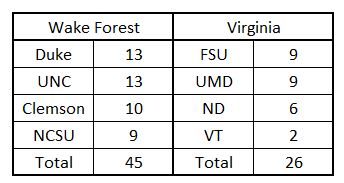
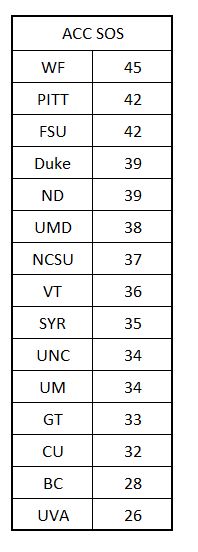
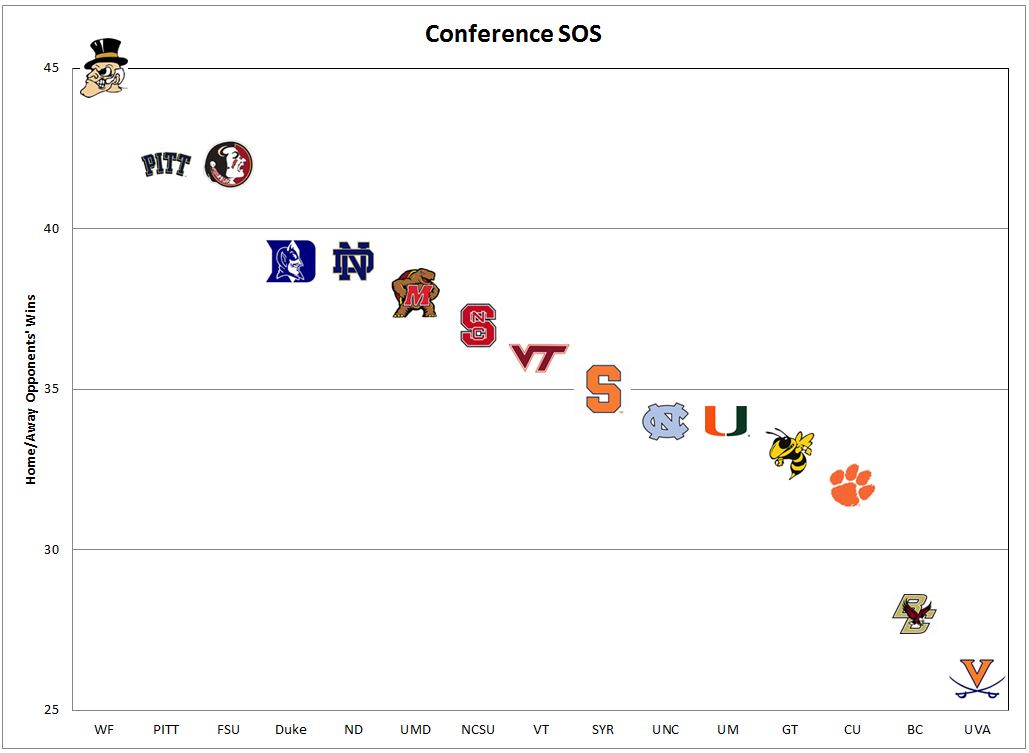
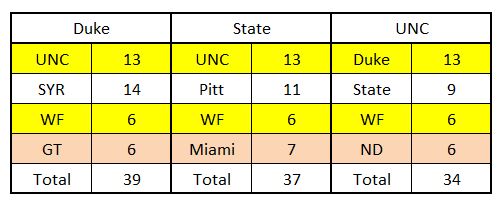
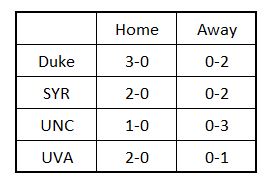
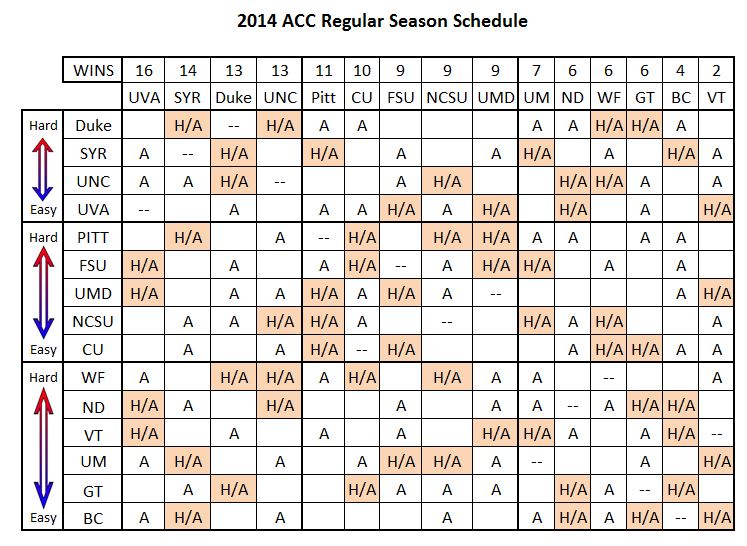

You must be logged in to post a comment.